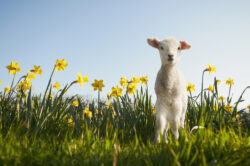Ready for a spring in your step? (Picture: Getty)
The cold snap is not helping many people get over the post-Christmas / January blues.
Combine this miserable weather with the abundance of Easter treats already on shelves, and people might just be counting down to Spring, lighter days, and all the joys that come with the season of new beginnings.
And who doesn’t love the Easter bank holidays that roll around every April?
So, when is Spring going to be sprung – and what’s the equinox all about?
Here is all you need to know about Spring 2023.
When is the first day of Spring 2023?
There are two schools of thought when defining the first day of spring. It depends on whether you are using the meteorological or astronomical definition of the seasons.
When spring is first sprung depends on which calendar you use (Picture: Getty)
The meteorological method splits the year into four seasons of three full months each based on the Gregorian calendar.
According to this, spring begins on March 1 and lasts until May 31 every year, with summer starting on June 1.
The astronomical season depends on the date of the spring equinox, which means the date comes later and can vary slightly from year to year.
In 2023, the spring (also known as vernal) equinox falls on Monday, March 20.
The astronomical spring will then last until the summer solstice, which in 2023 is on Wednesday, June 21.
What is the spring equinox?
The spring equinox was used by early civilisations to keep track of the seasons.
Stonehenge is a popular meeting point during the equinoxes (Picture: Getty)
Equinoxes get their name from the Latin for ‘equal night’, and mark the only two points in the year when the equator is the closest part of Earth to the sun, with both the northern and southern hemispheres sharing sunlight equally.
For six months each of the year, either the northern or southern hemisphere is pointing slightly more towards the sun, bringing the warmer temperatures of spring and summer.
More: Trending
The autumnal and spring equinoxes mark the point when the two hemispheres swap over, while the summer and winter solstices denote the sun reaching its most northerly and southerly points.
While the solstices are more widely understood to be rooted in ritualistic tradition and celebration, the equinoxes carry meaning for many people too.
In the UK, Stonehenge is the most famous meeting point for druids and pagans during equinoxes and solstices, who traditionally gather to watch dawn break.
MORE : When do the clocks change in 2023 – and when will they go forward or back?
MORE : When is the next bank holiday? Full list of 2023 dates
Follow Metro across our social channels, on Facebook, Twitter and Instagram
Share your views in the comments below
Warm, sunny evenings are getting closer.





